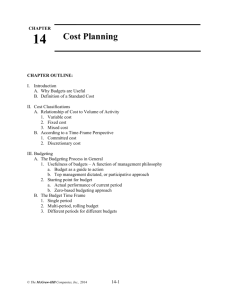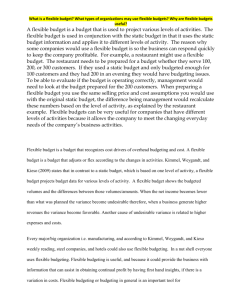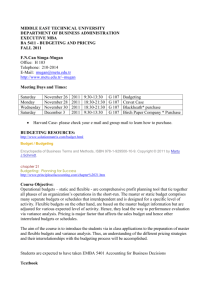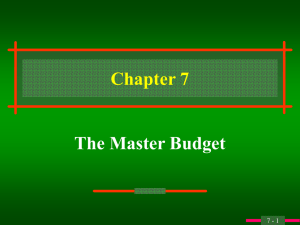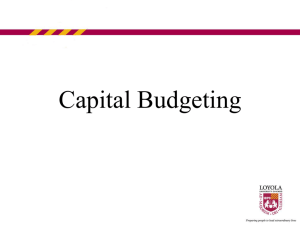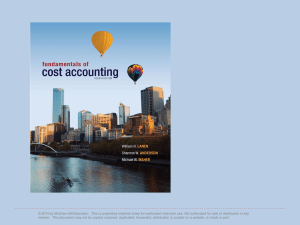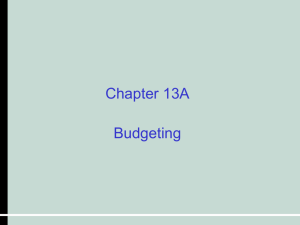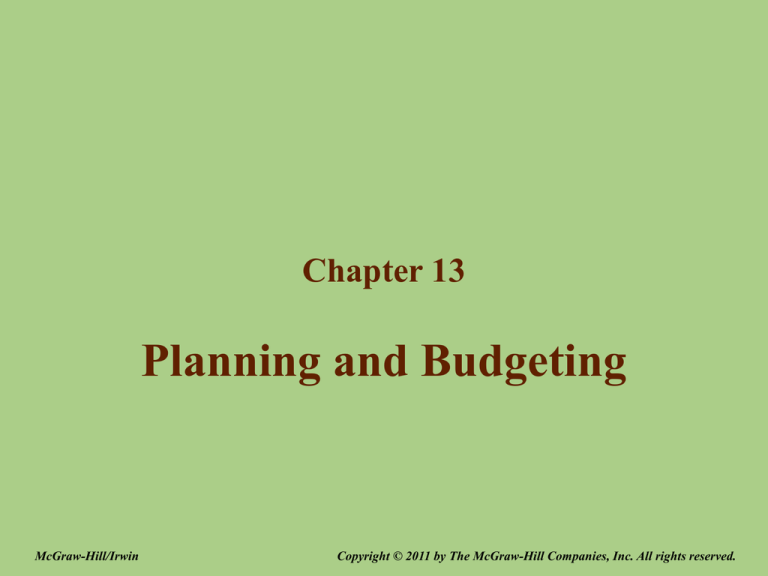
Chapter 13
Planning and Budgeting
McGraw-Hill/Irwin
Copyright © 2011 by The McGraw-Hill Companies, Inc. All rights reserved.
LO1
Budgets
L.O. 1 Understand the role of budgets in overall organization plans.
• A budget is a financial plan of the resources needed
to carry out activities and meet financial goals.
• Budgets play an important role in managing cash flows.
• Critical success factors are the strengths of a
company that enable it to outperform competitors.
13 - 2
Human Element in Budgeting
L.O. 2 Understand the importance of people in the budgeting process.
Organization
goals
Goal congruence
Individual
goals
• Participative budgeting:
Use of input from lower- and middle-management
employees; also called grass roots budgeting
13 - 3
Sales Forecasting
L.O. 3 Estimate sales.
• Forecasting sales is the most difficult aspect of budgeting.
Sales staff
Market researchers
Delphi technique
Trend analysis
Econometric models
13 - 4
Forecasting Production
L.O. 4 Develop production and cost budgets.
• A production budget is a plan of resources needed
to meet current sales demand and ensure that
inventory levels are sufficient for future sales.
Beginning balance
+
BB
Transfers in
TI
–
Units in beginning
+
inventory
Required
production
–
Transfers out
= Ending balance
TO
Budgeted
sales
=
Units in ending
inventory
13 - 5
Cash Budget
L.O. 5 Estimate cash flows.
• The cash budget is a statement of cash on hand at
the start of the budget period, expected cash receipts,
expected cash disbursements, and the resulting cash
balance at the end of the budget period.
• Cash receipts:
– Collection of accounts receivable
– Cash sales
– Sales of assets
– Borrowing
– Issuing stock
– Other
13 - 6
LO5
Cash Budget
• Cash disbursements:
– Materials purchases
– Manufacturing costs
– Operating activities
– Debt repayment
– Acquisition of new assets
– Income taxes
– Dividends
– Other activities
13 - 7
LO5
Cash Collections Example
Santiago Pants
Monthly Collection Experience
Sales on Credit
Cash collected from current month's sales
Cash collected from last month's sales
Cash discounts taken (percentage of gross sales)
Written off as bad debt
Total disposition of credit sales in current month
20%
75
2
3
100%
Expected Sales for Three Months
January sales
February sales
March sales
$500,000
$450,000
$600,000
13 - 8
LO5
Cash Collections Example
Santiago Pants
Multiperiod Schedule of Cash Collections
For the Quarter Ended March 31
Month
January
Beginning accounts receivable,
January 1, $540,000
January sales, $500,000a
February sales, $450,000b
March sales, $600,000c
Total cash collections
$540,000
100,000
$640,000
February
$375,000
90,000
$465,000
March
Total for
Quarter
$337,500
120,000
$457,500
$ 540,000
475,000
427,500
120,000
$1,562,500
a
20% collected in January, 75% collected in February, and 5% not collected
20% collected in February, 75% collected in March, and 5% not collected
c 20% collected in March, 75% collected in April, and 5% not collected
b
13 - 9
LO5
Cash Disbursements Example
Santiago Pants
Monthly Disbursements for Purchases Experience
Cash disbursement for current month's purchases
Cash disbursement for prior month's purchases
Cash discounts taken
Total cash disbursement for purchases
50%
48
2
100%
Expected Purchases for Three Months
January sales
$120,000
February sales
$200,000
March sales
$250,000
13 - 10
LO5
Cash Disbursements Example
Santiago Pants
Multiperiod Schedule of Cash Disbursements
For the Quarter Ended March 31
Month
January
Beginning accounts payable,
January 1, $256,000
January purchases, $120,000a
February purchases, $200,000b
March purchases, $250,000c
Additional cash payments
Total cash disbursements
$256,000
60,000
250,000
$566,000
February
$ 57,600
100,000
250,000
$407,600
March
Total for
Quarter
$ 96,000
125,000
250,000
$471,000
$ 256,000
117,600
196,000
125,000
750,000
$1,444,600
a
50% paid in January, 48% paid in February, and 2% discounts taken
b 50% paid in February, 48% paid in March, and 2% discounts taken
c 50% paid in March, 48% paid in April, and 2% discounts taken
13 - 11
Budgeted Balance Sheet Example
L.O. 6 Develop budgeted financial statements.
Santiago Pants
Budget Balance Sheet
For the Budget Year Ended December 31 ($000)
Budget Year
Assets
Current assets:
Cash
Accounts receivable
Inventories
Other current assets
Total current assets
Long-term assets:
Property, plant, equipment
Less: Accumulated depreciation
Total assets
Balance
Jan 1
Additions Subtractions
Balance
Dec 31
$ 830
540
155
161
$1,686
$ 6,940
7,200
4,265
-0$18,405
$ 7,399
6,840
3,995
100
$18,334
$ 371
900
425
61
$1,757
1,866
(1,246)
$2,306
1,470
-0(220)
-0$19,651 $18,334
3,336
(1,470)
$3,623
13 - 12
LO6
Budgeted Balance Sheet Example
Santiago Pants
Budget Balance Sheet
For the Budget Year Ended December 31 ($000)
Budget Year
Balance
Jan 1
Liabilities and Shareholders Equity
Current liabilities:
Accounts payable
Taxes payable
Current portion of long-term debt
Total current liabilities
Long-term liabilities
Total liabilities
Shareholders' equity
Common stock
Retained earnings
Total shareholders
Total liabilities and shareholders equity
Additions Subtractions
Balance
Dec 31
$ 256
187
23
$ 466
258
$ 724
$1,715
550
23
$2,288
-0$2,288
$1,694
350
23
$2,067
23
$2,090
$ 277
387
23
$ 687
235
$ 922
$ 437
1,145
$1,582
$2,306
$ -01,149
$1,149
$3,437
$ -030
30
$2,120
$ 437
2,264
$2,701
$3,623
13 - 13
Budgeting in Service Organizations
L.O. 7 Explain budgeting in merchandising and service organizations.
Sales forecast
Budgeted cost
of services
Budgeted
income
statement
Cash budget
Marketing and
administrative
cost budget
Budgeted
balance sheets
13 - 14
Ethical Problems in Budgeting
L.O. 8 Explain why ethical issues arise in budgeting.
• Budgets can create serious ethical issues
for many people.
• The company must recognize the trade-off
between encouraging unbiased reporting by
managers and the use of budget information
in performance evaluation and rewards.
13 - 15
Budgeting Under Uncertainty
L.O. 9 Explain how to use sensitivity analysis
to budget under uncertainty.
• Budgets allow management to explore many
alternatives.
• Spreadsheets are helpful in preparing budgets
and quantifying “what-if” conditions.
13 - 16
End of Chapter 13
McGraw-Hill/Irwin
Copyright © 2011 by The McGraw-Hill Companies, Inc. All rights reserved.



